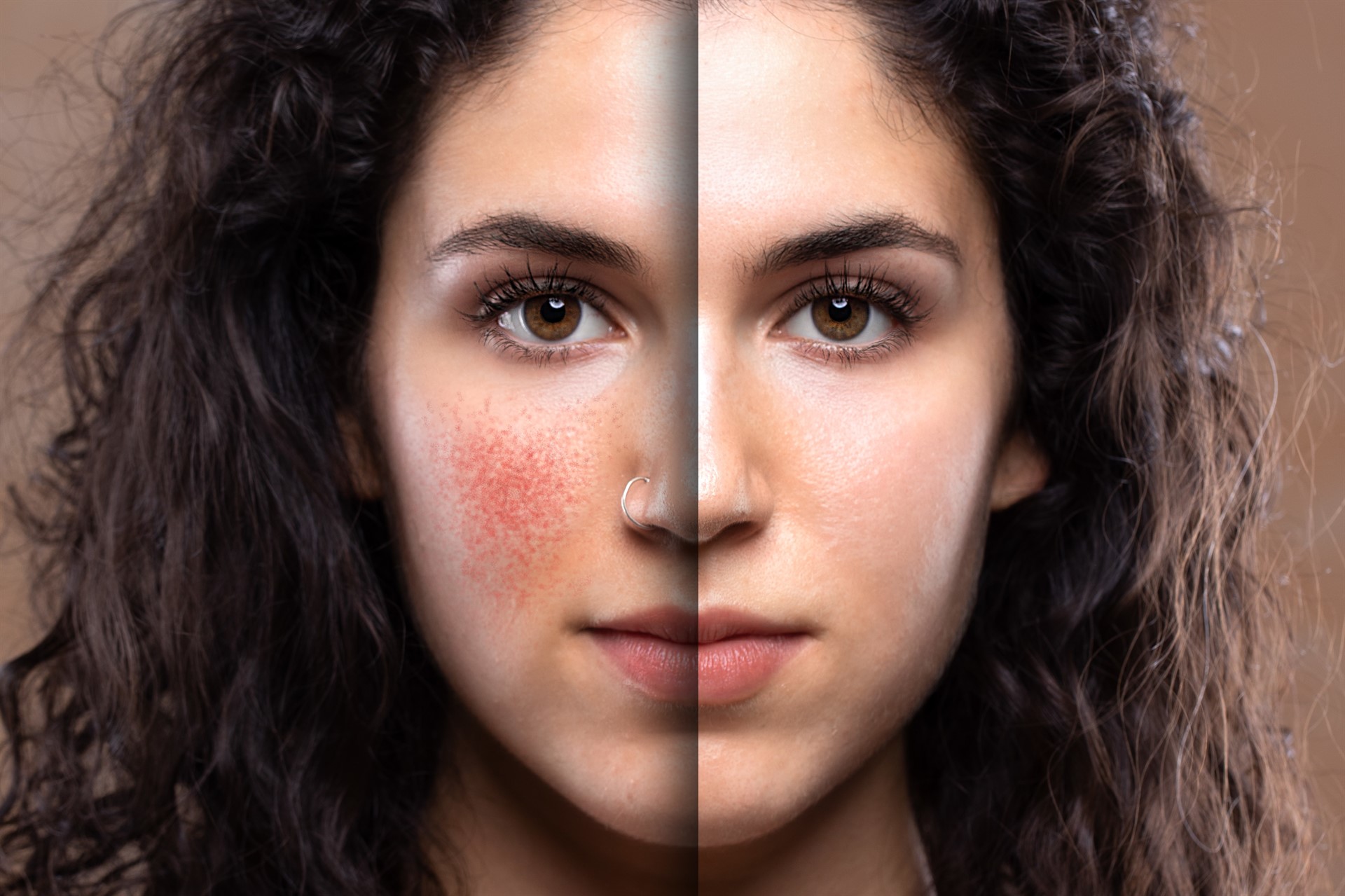Rosacea—The Good, the Bad, and the Red

You’ve just turned 35. You look into the mirror and notice a few more gray hairs, lines, and wrinkles around the eyes. And, wait, what is that? You also see your face is a little more red… all the time. And why am you getting acne? It’s across your nose, the apples of your cheeks, and a little in the mid forehead. Hmmmm. You haven't been out in the sun, so likely not sunburned. Now you start investigating closer. You stare into your magnifier mirror and see a lot of squiggly red lines. Now you remember your mom. She has the same thing, just a lot more redness than you. When did this start happening, anyway?
Rosacea affects about 16 million people in the US, many of these individuals might not even know they have the skin disorder. It occurs most often between the ages of 30-60, but can truly affect anyone and causes redness in the skin on the nose, cheeks, forehead, and chin predominantly. And no, just because your skin may be red, does not mean you have rosacea, but it could be one of the signs. It can also cause papules, pustules, or even increased growth of tissue in certain areas, burning/stinging, swelling, etc.
Rosacea’s origins and worsening factors:
Genetics does play a role in rosacea, as it is seen that if you have other family member with rosacea, you are at a higher risk of developing rosacea as well.
Many things can cause worsening of the condition, such as:
Weather conditions—harsh weather, sun exposure
Stress
Overheating, hot baths, saunas, etc
Beverages—red wine, hot beverages
Hot/spicy foods
Certain topical medications should be avoided
Harsh skin care cleansers/soaps, astringents, toners, abrasive exfoliators, products containing:
Alcohol
Harsh fragrance
Menthols
Camphor
Witch hazel
Peppermint
Eucalyptus oil
See your doctor to address your rosacea, as you will need treatment to prevent further damage and prevent it from progressing. There are treatments available for any of the forms of rosacea. There are 4 different subtypes of rosacea identified now and multiple different treatments are available to treat these. Some require oral antibiotics, topical antibiotics, light therapies, laser therapies and other treatments to give you the best outcome. This is an ongoing disorder that you will continue to need to treat and deal with. It doesn’t go away, but it is manageable with continued care.
A good medical-grade skincare regimen at home is highly recommended, but is only the initial step in treatment. Wash your skin with lukewarm water with two cleanses morning and night. Use gentle pressure only with the balls of the fingertips. Once the steps below are completed, then apply the broad spectrum sunscreen every morning and throughout the day if in the sun. Do not rely on your SPF in your make up to protect you.
Avoid waterproof cosmetics and heavy foundations that are difficult to remove without irritating solvents or physical scrubbing. This will only lead to worsening redness and rosacea.
Skincare Regimens:
Rosacea and Breakouts: For those who have a red and rosacea-prone skin but also break out a lot.
· Chamomile Facial Cleanser (Alternative for dry skin, use Lavender Creamy Cleanser)
· ResurFACE Crèmeà Some may be able to use this gently, others may not. This will be advised after your consultation
· Vita-C Peptide Spray
· C-Stem—for age/acne spots
· Green Tea Antioxidant Serum—moderate/oily skin
· Vitamin K Crème—apply to red areas only
· Vita Soothe—for flaky/irritated skin
· O2 lift Mask, use 2-3 times weekly
· Ultra Firming Neck & Chest
· Oil Free Moisturizer or Ultra Benefits
· Daily Replenishing SPF 30+
Rosacea Home Care: for non-acne prone skin or dry skin types
· Lavender Creamy Cleanser
· Vita-C Peptide Spray
· C-Stem
· Soothing Skin Relief Gel
· Vita Soothe
· Vitamin K Crème—apply as target treatment to red areas
· O2 Lift Mask—use 2-3 times/week
· Ultra Firming Eye
· Ultra Benefits—in a.m.
· Multi-Complex Night Crème—in p.m.
· Daily Replenishing SPF 30+
Please contact us for a consultation. We’d love to hear from you.
Shari J. Twigg, MD
Board Certified in Aesthetic Medicine
Advanced Aesthetics
304 South Ellery Avenue, Suite 2
Fairview, MT, 59221
406-742-5256
